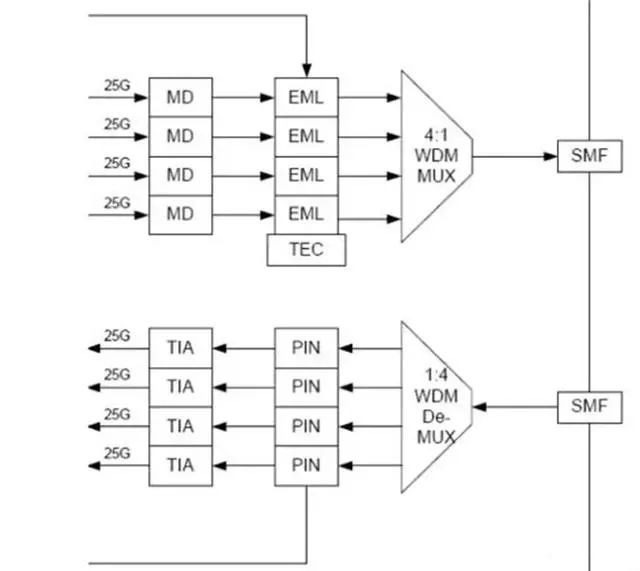

 Knowledge Base +
Knowledge Base +  2024.01.26
2024.01.26Currently, the mainstream 100G optical modules are QSFP28 optical modules, which include QSFP28-SR4, QSFP28-LR4, QSFP28-PSM4, and QSFP28-CWDM4.
QSFP28 CWDM4 vs QSFP28 LR4
The QSFP28 CWDM4 standard is mainly for the deployment of 100G links within 2km in data centers, and the interface of QSFP28 CWDM4 optical modules conforms to the duplex single-mode 2km 100G optical interface specification, with a transmission distance of up to 2km. it is the most widely used 100G QSFP28 series of optical modules in data centers at present.
The capability of QSFP28 LR4 completely covers QSFP28 CWDM4, but in the scenario of 2km transmission, the CWDM4 solution has lower cost and is more competitive.
The following figure shows the schematic of QSFP28 LR4 as well as QSFP28 CWDM4:

◮ QSFP28 LR4 Schematic Diagram
_1706247866.jpg)
◮ QSFP28 CWDM4 Schematic
LR4 and CWDM4 are similar in principle in that they both multiplex four parallel 25G channels WDM over a single 100G fiber link via the optics MUX and DEMUX. However, there are several differences between the two:
LR4 uses more expensive optical MUX/DEMUX devices.
LR4 uses more expensive lasers with higher power consumption
LR4 requires an additional TEC (thermoelectric cooler)
Based on the above three points, the optical module of QSFP28 LR4 standard is more costly, so the QSFP28 CWDM4 standard proposed by MSA well supplements the gap caused by the high cost of QSFP28 LR4 within 2km.
QSFP28 PSM4 vs. QSFP28 CWDM4
In addition to CWDM4, PSM4 is also a medium-distance transmission solution, so what are the advantages and disadvantages of PSM4 compared to CWDM4?
QSFP28 PSM4 optical module is a single-mode parallel four-way optical module, mainly suitable for 500m applications.
The QSFP28 PSM4 specification defines a point-to-point 100 Gbps link of eight single-mode fibers (four transmit and four receive), with each channel sending at 25 Gbps. Four channels of the same wavelength and independent of each other are used for each signal direction. Therefore, the two transceivers typically communicate over an 8-fiber MTP/MPO single-mode patch cable. the PSM4 has a maximum transmission distance of 500 m. The PSM4 can be used to transmit over a distance of up to 1,000 km.
_1706248133.jpg)
◮ PSM4 schematic
Briefly summarized, as shown in the figure below, because of the use of WDM, so the cost of the CWDM4 optical module is higher than the PSM4 optical module, but the CWDM4 transceiver bidirectional only two single-mode optical fibers, much less than the PSM4 8 single-mode fibers, with the increase in distance, the total cost of the PSM4 scheme rises very quickly. In practice, the decision to use PSM4 or CWDM4 needs to be based on the interconnection distance.
◮ CWDM4 vs PSM4
For optical module suppliers, the future demand for data center optical modules, high speed, low power consumption, low cost is the main criterion. There are different programs in terms of transmission distance, modulation, operating temperature and packaging, which need to be combined with application scenarios, costs and other factors to choose.
Additional Learning Hub Resources
What is the difference between a single mode SFP and a multimode SFP Beginners Guide
Subscribe to the newsletter
for all the latest updates.
2-5# Building, Tongfuyu Industrial Zone, Aiqun Road, Shiyan Street, Baoan District, Shenzhen. China
